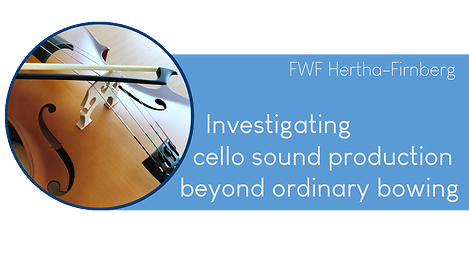 "Investigating cello sound production beyond ordinary bowing" is a project within the Hertha Firnberg Programme for post-docs, funded by the Austrian Science Fund FWF.
"Investigating cello sound production beyond ordinary bowing" is a project within the Hertha Firnberg Programme for post-docs, funded by the Austrian Science Fund FWF.
This project takes place within the Doksari framework. For more details, visit https://iwk.mdw.ac.at/doksari/.
| Project number: | FWF T 1295-G |
| Project leader: | Montserrat Pàmies-Vilà |
| Research institution: | Department of Music Acoustics – Wiener Klangstil (IWK) University of Music and Performing Arts Vienna |
| Project Team: | Montserrat Pàmies-Vilà, Vasileios Chatziioannou, Alexander Mayer, Anna Scheiblauer |
| Mentor: | Werner Goebl |
| Cooperation Partner: | Charalampos Saitis, Queen Mary University of London |
| Date of approval: | 21.06.2021 |
| Project start: | 01.09.2021 |
| Project end: | 31.05.2025 |
| Scientific areas: | 103, Physics (55 %) 604, Arts (45 %) |
| Keywords: | Music acoustics, Bowed-string instruments, Performance Science, Sound analysis |
| Project data: | http://doi.org/10.5281/zenodo.10696679 |
Abstract
Music acoustics is the discipline that studies the function of music instruments. During the last century, numerous studies have analysed the production of sounds, the vibrations of several parts of the instruments and the manner instruments transmit sound to the audience. The analysis of the playing techniques that musicians use to achieve different sounds has required new experimental methods and computer simulations in order to fully cover the wide range of sounds that instruments produce. In bowed string instruments, such as the violin or the cello, the friction that takes place at the position where the bow hairs touch the string is mainly responsible for the sound production. To achieve a bowed sound, players precisely control the speed and the force of the bow in order to produce a so-called stick-slip motion, where the bow sticks to the string during few milliseconds and then the string quickly slips back before the next cycle of oscillation begins. At least this is what is expected from an ordinary bowed-string sound. These instruments, though, can achieve a large variety of sound textures. For example, by adjusting the bowing pressure on the strings or by bowing on other parts of the instrument or even using the wooden part of the bow, composers and players have explored new sound effects giving birth to ‘non-ordinary’ playing techniques. Such techniques challenge the way acoustics has defined the production of bowed-string sounds, showing the need for more systematic research. This project is dedicated to the study of non-ordinary bowing techniques on the cello. The main objective of the project is to analyse the bowing technique in cello performance while linking three experimental approaches. The first study will characterise the sound and movements of experienced cello players when they perform traditional and non-ordinary bowing techniques. To do that, motion-capture technology will record the movement of the bow during playing while sensors on the instrument will measure its vibration. Secondly, a robotic arm will be used in combination with sensors to create a fine-controlled bowing device where the bowing actions can be reproduced and analysed accurately. The third part of the project will be dedicated to evaluate the performance of the bowing device. This will consist of acoustical analyses of the recorded signals as well as listening tests where expert cello players will compare the sounds produced by players with those produced using the device. By combining these methodologies, the project will establish in which way every characteristic of the performed sounds depends on each of the player actions. This will result in a systematic description of the interactions between cellists and their instruments that will lead to a better understanding of the physics taking place during cello sound production.
Publications
Pàmies-Vilà, Montserrat; Mayer, Alexander; Matusiak, Ewa, and Chatziioannou, Vasileios (2024)
"A method for the reproduction of cello bow kinematics using a robotic arm and motion capture,"
Acta Acustica 8(45). DOI↗
Pàmies-Vilà, Montserrat, and Saitis, Charalampos (2024)
"Timbral effects of col legno tratto techniques on bowed cello sounds (abstract),"
The Journal of the Acoustical Society of America 155, A60 (2024) - ASA Meeting in Ottawa DOI↗
Pàmies-Vilà, Montserrat (2024)
"Extended playing techniques as a source of unusual acoustic phenomena to explore with music students (abstract),"
The Journal of the Acoustical Society of America 155, A194 (2024) - ASA Meeting in Ottawa DOI↗
Mayer, Alexander; Pàmies-Vilà, Montserrat, and Chatziioannou, Vasileios (2023)
"Ein Roboterarm spielt Cello,"
OCG 48(4), 16-19.
Pàmies-Vilà, Montserrat; Matusiak, Ewa; Chatziioannou, Vasileios, and Mayer, Alexander (2023)
"A cello bowing playback device? Motion capture meets robotic arm,"
in 10th Convention of the European Acoustics Association, Forum Acusticum p. 2749-2756. DOI↗
Scheiblauer, Anna; Mayer, Alexander, and Pàmies-Vilà, Montserrat (2022)
"Investigating the cello position, bow motion and cellist posture using motion capture,"
in Proceedings of meetings on acoustics Acoustical Society of America; Fourth Vienna Talk on Music Acoustics 49, p. 035013. DOI↗
Pàmies-Vilà, Montserrat and Chatziioannou, Vasileios (2022)
"Künstliche Saitenanregung mittels Roboterarm (poster),"
in Proc. DAGA 2022, Stuttgart.
Pàmies-Vilà, Montserrat; Scheiblauer, Anna; Mayer, Alexander, and Chatziioannou, Vasileios (2022)
"A framework for the analysis of bowing actions with increased realisticness,"
in 24th International Congress on Acoustics, ICA 2022 (Gyeongju, Korea).
Mayer, Alexander; Chatziioannou, Vasileios, and Pàmies-Vilà, Montserrat (2022),
"The Universal Robots Real-Time Data Exchange (RTDE) and LabVIEW,"
Universität für Musik und darstellende Kunst Wien. DOI↗
Pàmies-Vilà, Montserrat; Mayer, Alexander, and Chatziioannou, Vasileios (2021)
"Reproducible excitation of string instruments using a robotic arm (abstract),"
Journal of the Acoustical Society of America (JASA) 150(4). DOI↗
